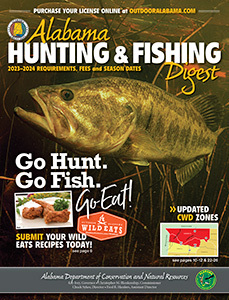You are viewing 2023's Dove Seasons & Limits. Click to here to view information for 2022
Dove Seasons & Limits
Mourning and White-Winged Dove
Note: At time of printing, federal guidelines were not final. See Alabama Waterfowl Hunting Guide.
North Zone (All counties except those listed below in south zone.)
- Limit 15 a day (90 days)
Split Season with Shooting Hours:
- 12 o’clock noon until Sunset -
(Afternoon Shooting Only) September 2 - One-half hour before Sunrise until Sunset -
(All Day) September 3 – October 22 - One-half hour before Sunrise until Sunset -
(All Day) November 18 – November 26 - One-half hour before Sunrise until Sunset -
(All Day) ) December 16 – January 14
South Zone
Baldwin; Coffee; Covington; Dale; Escambia; Geneva; Henry; Houston; and Mobile.
- Limit 15 a day (90 days)
Split Season with Shooting Hours:
- 12 o’clock noon until Sunset -
(Afternoon Shooting Only) September 9 - One-half hour before Sunrise until Sunset -
(All Day) September 10 – October 29 - One-half hour before Sunrise until Sunset -
(All Day) November 18 – November 26 - One-half hour before Sunrise until Sunset -
(All Day) December 16 – January 14
It Is Legal To Hunt Doves On, Over, Or From...
- Lands or areas where seeds or grains have been scattered solely as the result of normal agricultural operations, which include normal agricultural harvestings, normal agricultural post-harvest manipulations, or normal agricultural practices.
- Lands planted by means of top-sowing or aerial seeding where seeds have been scattered solely as the result of a normal agricultural planting, a planting for agricultural soil erosion control, or a planting for post-mining land reclamation.
- Lands or areas where grain or feed has been distributed or scattered solely as the result of the manipulation of an agricultural crop or other feed on the land where grown.
- Standing crops.
- Lands planted as wildlife food plots, provided the seed is planted in a manner consistent with Cooperative State Research, Education, and Extension Service recommendations for the planting of wildlife food plots. In states without Cooperative Extension Service recommendations for the planting of food plots, the seed must be planted in accordance with Extension Service guidelines for producing a crop.
- Lands planted as pasture improvements or for the purpose of grazing livestock. (The Fish and Wildlife Service will not make a distinction between agricultural fields planted with the intent to gather a crop and those planted without such intent provided the planting is carried out in a manner consistent with the recommendations of State Extension Specialists).
- Standing or manipulated natural vegetation.
- A blind or other place of concealment camouflaged with natural vegetation.
For further clarification, see www.fws.gov/le/huntfish/whatislegal.htm.
The Alabama Cooperative Extension System recommends planting dates for some top sown grains between August 1 and November 30 depending on individual circumstances. For details see www.aces.edu/pubs/docs/A/ANR-1467/ANR-1467-low.pdf.

